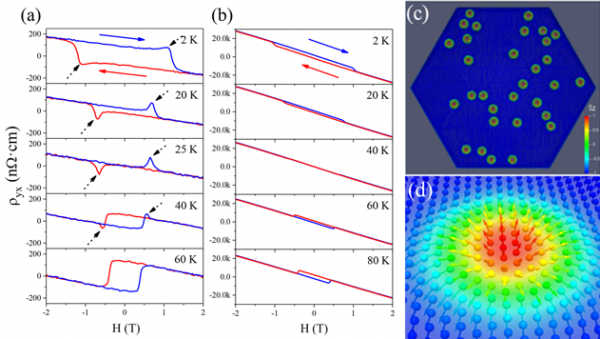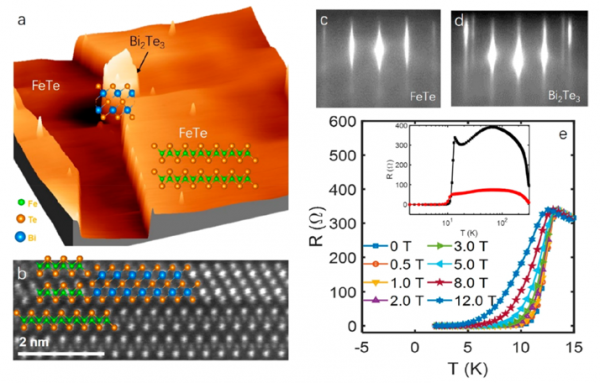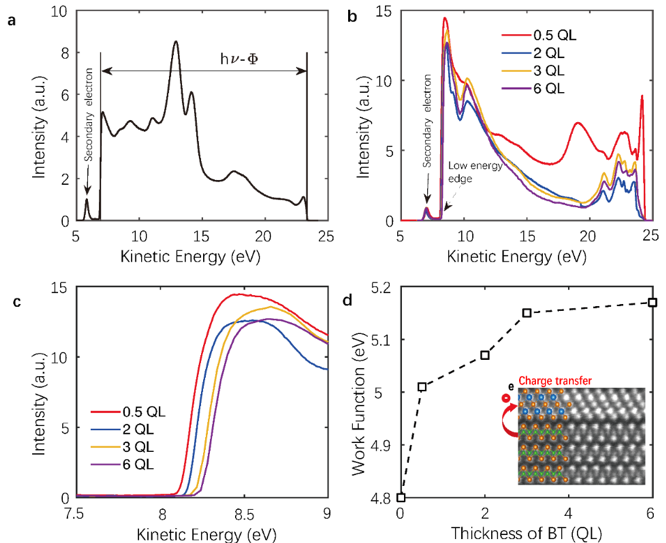Researchers reveal evolution of spin-orbit splitting near silicon isotope chains
2024-05-31Researchers obtain high-performance thermoelectric materials through trapped-hole release and pseudo-nanostructure
2024-05-20Researchers collaborate on world’s first synthesis and characterization of 2D all-organic perovskite crystals
2024-05-20Researchers report experimental findings on spin splitting behavior of antiferromagnets
2024-02-15Researchers reveal stack growth mechanism of wafer-scale van der Waals superconductor heterostructures
2023-09-07Researchers in the Department of Physics at SUSTech have made significant progress in magnetic skyrmions materials and topological interfacial superconductors. It potentially paves the way for the next generation storage and spintronics devices, while providing a platform for future research on topological quantum computation.
Assistant Professor Gan Wang led his research group to publish two research papers detailing their progress in magnetic skyrmions materials and topological interfacial superconductors. The earlier work was titled, “Evidence for Magnetic Skyrmions at the Interface of Ferromagnet / Topological-Insulator Heterostructures“, which looks for new magnetic skyrmions materials.
The most recent paper, titled “Superconductivity in Single-Quintuple-Layer Bi2Te3 Grown on Epitaxial FeTe” by the epitaxial growth of single-layer Bi2Te3 on FeTe,” are seeking the mechanism of superconductivity in topological interfacial superconductors. Both papers published in the professional journal Nano Letters.
The earlier paper published in Nano Letters, exploring the existence of magnetic skyrmions at the two-dimensional (2D) van der Waals (vdW) interface based on bismuth (Z number 83, hosting strong spin-orbital coupling (SOC) of 1.5 eV).
Magnetic skyrmions have been described as a topologically protected nano-scale spin texture. In physics, it can be treated as a quasi-particle, which has a very long lifetime and can be easily driven by many physical forces, including electric current, heat, and light. Moreover, the creation and annihilation of magnetic skyrmions could be regarded as the “1” and “0” states in information processing. It makes them potential new carriers for data storage/processor.
Theoretically, at the interface between non-magnetic heavy metals and magnetic metals, the broken inversion symmetry at the interface, together with the strong SOC from heavy metal, would produce a strong Dzyaloshinskii–Moriya interaction (DMI) for the nearby magnetic atoms. It would lead to the creation of magnetic skyrmions. Many studies are concentrated on the metallic bonding interfaces, while seldom are looking into 2D vdW interfaces. Recently, with 2D vdW magnetic material becoming a hot topic, there are significant research and commercial applications to explore the magnetic skyrmions within the 2D vdW interface.
In this paper, the heterostructures of the ferromagnet (Cr2Te3) and topological insulator (Bi2Te3) have been grown by molecular beam epitaxy. The detailed structural characterizations have unambiguously revealed the presence of intercalated hexagonal Bi bilayer nanosheet at the interface (Figure 1a). Those bilayer nanosheets are generated in the annealing process (researchers annealed Bi2Te3 before the continuous growth of Cr2Te3 top-layer). The growth of Cr2Te3 on bilayer Bi has been monitored by scanning tunneling microscope (STM), the clear moiré fringes have been observed on the Cr2Te3 surface (Figure 1b & 1c), indicating the interaction of electronic states between Cr2Te3/Bi interface.

Figure 1. (a) Scanning transmission electron microscopy (STEM) image of the interface of Bi2Te3/Cr2Te3 heterojunction; (b) In situ STM image of the Cr2Te3 top-layer grown on the Bi bilayer; (c) The moiré fringes on Cr2Te3 surface, which are produced by the modulation of bismuth bilayer structure.
The research team proved that the intercalated Bi bilayer was crucial for the appearance of the topological Hall Effect (THE) through a set of control experiments. It provides experimental evidence for the existence of magnetic skyrmions at the vdW interface between bilayer Bi and Cr2Te3 (Figure 2a & 2b). Furthermore, the research team used atomic spin dynamic simulations to verify their hypothesis, demonstrating the creation of magnetic skyrmion at the vdW interface (Figure 2c & 2d).

Figure 2(a): Hall measurement of the Bi2Te3/Bi/Cr2Te3 interface, the peaks/dips marked by a black arrow indicating the existence of THE; (b) Hall measurement of the Bi2Te3/Cr2Te3 heterojunction, without topological Hall effect; (c) Atomic spin dynamics simulation of the generation of magnetic skyrmions at the vdW interface between bilayer Bi and Cr2Te3; (d) The configuration of a magnetic skyrmion in (c).
SUSTech-NUS joint doctoral candidate Junshu Chen is the first author of the paper. Gan Wang, Institute of Quantum Science and Engineering (IQSE) Research Assistant Professor Bin Li, SUSTech Department of Physics Associate Professor Hongtao He and Yangzhou University School of Physical Science and Technology Associate Professor Bin Xi were the co-correspondent authors. SUSTech was the first communications unit.
The second paper, published in Nano Letters most recently, explored the evidence of interfacial superconductivity and superconducting mechanism of iron-based topological superconductor Bi2Te3/FeTe heterostructure.
As a 2D system, topological interfacial superconductivity not only provides a platform for studying the unconventional superconductivity but also offer new thoughts for detecting Majorana fermions. Bi3Te3/FeTe heterojunction is an excellent example of typical topological superconducting systems. However, up to now, there still lacks direct experimental evidence to convince the interfacial superconductivity of this system and also does not have a solid theoretical explanation of its superconducting mechanism.
In this paper, the research team successfully realized the vdW epitaxy of high-quality single quintuple layer (QL) Bi2Te3/FeTe heterostructure via MBE (Figure 3a-3d). Through electrical transport measurements, the 1 QL Bi2Te3/FeTe heterostructures showed good superconductivity with a critical temperature TC up to 13 K. This is identical with the results of thick Bi2Te3 sample (as demonstrated in Figure 3e), which indicates the thickness of Bi2Te3 are irrelevant with the superconductivity. Further, together with the scanning tunneling spectroscopy (STS) results of FeTe, 1 QL, and 2 QLs Bi2Te3 (Figure 4), only one single QL Bi2Te3 on FeTe could induce the superconductivity. All of these provide robust evidence for the interfacial superconductivity of the Bi2Te3/FeTe heterostructure.

Figure 3. (a)-(b) STM and STEM image of the single QL Bi2Te3/FeTe heterostructures; (c)-(d) Reflective high-energy electrons diffraction (RHEED) pattern of sample surface; (e) Transport results of single QL Bi2Te3/FeTe heterostructures.

Figure 4. (a) 3D STM image of Bi2Te3 grown on FeTe; (b)-(c) STM image of surface atoms of FeTe and Bi2Te3; (d) STS spectra and (e) temperature-dependent STS spectra obtained on single QL Bi2Te3; (f) A series of STS spectra obtained by equidistant displacement along on single QL Bi2Te3/FeTe and (g) 2 QLs Bi2Te3/FeTe. (h) The broad STS spectra on the sample surface.
The research team also attempt to study the superconducting mechanisms behind the system. Through detailed STM and scanning tunneling spectroscopy (STS) study, a significant shift of density of states (DOS) between the different thicknesses Bi2Te3 layers has been discovered (in Figure 4h). To further analyze the shift, the research team has employed ultraviolet photoelectric spectroscopy (UPS) to calculate the working function (WF) for FeTe and different thickness Bi2Te3. They found the WF of Bi2Te3 surface is much larger than FeTe. It would keep increasing with the thickness of Bi2Te3 layers (saturated at 5 QLs Bi2Te3). These indicate the existence of electron transfer from FeTe to Bi2Te3 at the interface. Hence, providing a rational explanation of the superconducting mechanism in this system, (that is, the charge (electron) transfer from FeTe to Bi2Te3), would suppress the antiferromagnetic ordering in FeTe. It, therefore, induces the interfacial superconductivity in Bi2Te3/FeTe heterostructures.

Figure 5. (a) DOS measured by UPS of FeTe and (b) Bi2Te3 with different thicknesses; (c) Low energy region of (b); (d) the WF versus Bi2Te3 thicknesses, inserting figure is a schematic diagram of electron transfer.
Research Assistant Professor Hailang Qin is the first author of the paper. Gan Wang, SUSTech Department of Physics Associate Professor Hongtao He, Assistant Professor Jiawei Mei, and Teaching Professor Fei Ye were all co-corresponding authors. SUSTech was the first correspondent unit. Additional contributions came from the Shenzhen Institute of Quantum Science and Engineering (IQSE), Yangzhou University (School of Physical Science and Technology), and the Hong Kong University of Science and Technology (HKUST) (Department of Physics).
The above two works were supported by the National Natural Science Foundation of China (NSFC), the National Key R&D Program, the State Key Laboratory of Low-Dimensional Quantum Physics, the Guangdong Natural Science Foundation, the Guangdong Innovation and Entrepreneurship Research Team Program, and the Shenzhen Science and Technology Innovation Committee.
Links to related articles:
https://pubs.acs.org/doi/10.1021/acs.nanolett.9b02191
https://pubs.acs.org/doi/10.1021/acs.nanolett.9b05167
Link to related news:
https://newshub.sustech.edu.cn/zh/html/202005/36267.html
https://newshub.sustech.edu.cn/?p=25151